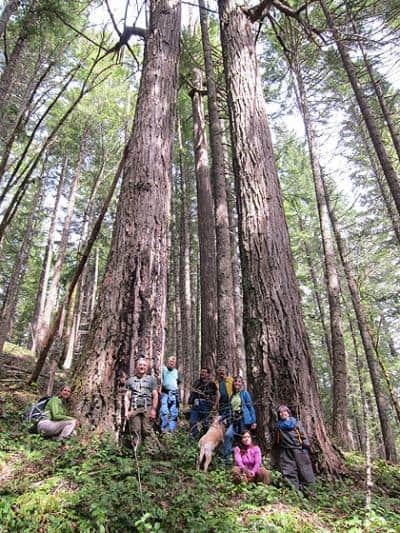 This post is a followup to Matthew’s comment here:
This post is a followup to Matthew’s comment here:
Finally, the notion that judges should decide legal issues surrounding the Forest Service because they are not forestry experts is in interesting one. Fact is, judges aren’t necessarily experts in divorce, murder, theft, DUI’s, bribery, etc either….but they rule on cases involving these issues all the time. What federal judges are experts in is the laws of this nation, and unfortunately, too many times, the Forest Service fails to comply with those laws
It occurs to me that many of you might not be aware of the context around the broader issues of courtroom decisions and other kinds of expertise, including scientific expertise. Within the science and technology studies literature, you may find many folks who have studied scientific issues and how they are handled in the courts. Our world is not separable from that world. Dr. Sheila Jasanoff‘s book
“Science at the Bar:Law Science and Technology in America” is considered by many to be the fundamental work in this area, and well worth a read.
Unfortunately, I couldn’t easily lay my hands on my copy of the book, but I did find a review here in the New England Journal of Medicine.
SCIENCE AT THE BAR: LAW, SCIENCE, AND TECHNOLOGY IN AMERICA
By Sheila Jasanoff. 285 pp. Cambridge, Mass., Harvard University
Press, 1995. $29.95. ISBN 0-674-79302-1.
To many physicians, science in the courtroom means trouble. Science, it is claimed, deals with objective facts and theories whose validity can be judged only by those with lengthy training in scientific method. Law, in contrast, involves rules and regulations applied by judges and juries almost always lacking competence — and often demonstrating striking incompetence — in evaluating scientific evidence. Putting science at the bar is therefore an invitation to outrageous malpractice awards, to the testimony of charlatans who are taken seriously by juries, to the awarding of irrationally large damages in “toxic tort” cases in the absence of scientific evidence of toxicity, to lay interference in the conduct of medical research, and to a familiar litany of judicial errors.But Sheila Jasanoff, in this broad-ranging and authoritative survey of the relation between law, science, and technology, presents a far more nuanced and complicated picture. Jasanoff, trained as a lawyer and subsequently the creator of Cornell’s flagship department of science and technology studies, has devoted most of her professional life to studying science in the courtroom. Her conceptual framework draws on the emerging field of science studies. In recent decades, this field has come to redefine science not simply as the discovery of the truths of nature, but also as a complex, problematic, error-prone, controversy-ridden process of “constructing” a view of the natural world that may, with luck, rhetorical skill, and time, eventually come to be accepted as mainstream, or “textbook” science.
Thus redefined, science begins to look much more like law. And the notion that the courts should simply ascertain “the established scientific view” appears, at least in many cases, similar to the search for a chimera. For as Jasanoff shows in her many examples, most of them involving biomedical matters, the courts are almost always called on in areas where empirical research is inconclusive, scientific opinion is divided, decisive epidemiologic studies have not been completed, or legislatures have not been willing to provide a framework to govern the application of — for example — new reproductive
and life-prolonging forms of technology. As she puts it, “courts, like regulatory agencies, conduct the bulk of their scientific inquiries ‘at the frontiers of scientific knowledge’ where claims are uncertain, contested and fluid, rather than against the background of largely settled ‘mainstream’ knowledge.”
….Jasanoff concludes with suggestions for a “more reflective” alliance between law and science. She is well aware of the many egregious errors made by the courts. But in the end, she sees the relation of science and law in America as generally positive, as granting the legal system a “limited and highly
contingent ability to interrogate the scientific community,” as encouraging scientific “reflection and self criticism,” and in general, as encouraging the advance of science and ratifying the positive American view of science and technology. For any serious student of science and law in America, this is an original and essential book
Interestingly, in the search for the review, I also ran across this article by Dr. Jasanoff:
“Is science socially constructed—And can it still inform public policy?” Here is the link:
Abstract
This paper addresses, and seeks to correct, some frequent misunderstandings concerning the claim that science is socially constructed. It describes several features of scientific inquiry that have been usefully illuminated by constructivist studies of science, including the mundane or tacit skills involved in research, the social relationships in scientific laboratories, the causes of scientific controversy, and the interconnection of science and culture. Social construction, the paper argues, should be seen not as an alternative to but an enhancement of scientists’ own professional understanding of how science is done. The richer, more finely textured accounts of scientific practice that the constructivist approach provides are potentially of great relevance to public policy.
which sounds interesting, and relevant to this blog. You can read the first two pages online but it costs $40 to read the whole thing. Published in 1996. Of course, Dr. Jasanoff does not work for a public university, but still..





